|
By Richard Lunsford with special thanks to Acutus,
Jeff H., Jan O., Dawn, Robert Zebeck, Chris H., Evan D.,Wallob Hebel, Robyn &
others on the Turtle Forum!
Hi! Welcome to our ATP guide to choosing your
first land-based turtle. Whether you enjoy the personality of a tortoise, the
hunting of a box turtle or you are a vegetarian desiring a like-minded pet
tortoise, we hope you find help making the best choice here. We’ll look at a
variety of land-based turtle types, species of interest and talk about needs &
challenges facing the land turtle keeper. We’ll link you to online resources
such as our
ITTN affiliate
World Chelonian Trust, &
Tortoise Trust (amazing stores of quality information). Our goal is for you
to not only choose your turtle, but follow through & research it thoroughly by
following article hyperlinks. Note: In this article, ‘box turtle’
refers only to those native to the United States of America.
I.)
Introduction.
Many turtle
keepers try their hand at a land-based turtle. Some start out with one, often
wild-caught box turtles (though such aren’t the best choice). Some
believe a land-based turtle will be lower-maintenance or ‘simpler’ than an
aquatic (no canister filter!). Some like the ‘look’ of the land-based turtles
(most are more dome-shaped than aquatics), or have heard tortoises have a
reputation for being more ‘personable’ than most aquatics, some bordering on
affectionate (although no one should buy a turtle if such would be a ‘deal
breaker;’ reptiles are typically solitary creatures without much social
repertoire). A few may like a vegetarian pet (in which case you’re looking for a
tortoise). Some just liked how one at a pet shop or Reptile Expo.
looked. Hopefully you’re reading this before you buy.
Why not just
buy whichever one ‘looks good?’ Why research & choose one methodically? Lot’s of
reasons. These turtles live several decades & some can clear a century. Some
require special conditions that aren’t available if you relocate (i.e.: a
Sulcata in your backyard in Arizona is in trouble if you move to New York). If
you buy a turtle ill-suited to your area (Egyptian tortoise for humid area;
Eastern box for arid region; Russian tortoise for cool, damp basement
enclosure), it may die. A turtle ‘matched’ to your area may be less work. Your
first turtle should be a hardy species, not one with a rep. for being
problem-prone. Some turtles are hardy if you take certain measures (i.e.: stick
to captive-bred or at least take wild-caught exotics to a Vet for prophylactic
antibiotics to eliminate parasites).
II.)
Are Land-based Turtles Easier than Aquatics?
There is no consensus. They are
‘different.’ Let’s look at the basic enclosure requirements for each.
a.
Aquatics – typically either basking turtles (sliders,
painteds, cooters, maps) or bottom-walkers (musk turtles). Basking turtles are
shaped like an oblong Frisbee, musk turtles like an egg with a flat bottom. Wide
variety of sizes available. They can be kept in aquarium from 29-240 gallons
(depending on # & species; usually 75-125 gallons), ¾’ths water-filled, with a
submersible heater (w/heater guard), basking platform, heat lamp, UV-B emitting
bulbs, powerful canister filter (biological filtration important), some type of
substrate (for appearance, not a health issue) & require water changes of 20-90%
every 1-3 weeks. Refusal to eat is rare if healthy. Can be kept in outdoor ponds
but do fine indoors in large tanks. Aquatics move in 3 dimensions (including
vertical). The enclosure has 2 microclimates; 78° water & an 85-90° basking
platform.
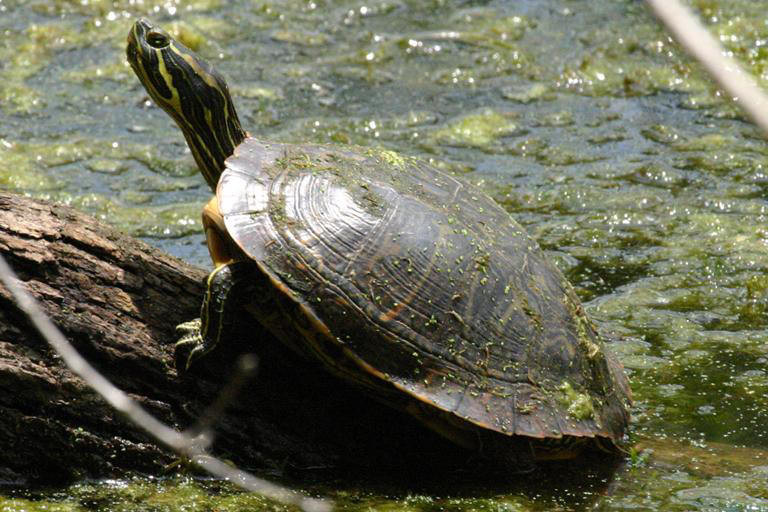
Wild Female Slider –
by Richard Lunsford
b.
Land Turtles – typically box turtles or tortoises. Heavy,
dome-shaped animals who don’t swim well. Range from fairly small (Egyptian
Tortoise; 3-toed box turtle) up to enormous. Can be kept indoors but the
consensus is that a good outdoor setup is best for overall
well-being. The smallest should be kept in at least a 40 gallon
Rubbermaid tub, & that’s awfully cramped. Most should have a 4’x4’ or larger
setup. Clear-walled enclosures (i.e.: aquariums) aren’t good. The substrate is
important to the animal & should allow burrowing. Indoors provide a UV-B
emitting fluorescent bulb (or a mercury-vapor bulb providing UV-B and
heat), & a heat lamp & some use an under-tank heating pad (but see Indoor
Enclosure section!) at one end to keep it warmer, making a thermal
gradient across the enclosure. Box turtles & a few tortoises need a soaking
pool that’s changed daily. You don’t need a submersible heater or canister
filter but waste-removal is manual & you must provide proper humidity levels.
Air circulation can be an issue. Refusal to eat is fairly common when stressed
for some species (i.e.: box turtles). Land turtles move in 2 dimensions (not
much vertical) so they get less usable space in a setup. The enclosure needs a #
of microclimates; a warmer end, a cooler end, hide boxes, for some a humid
substrate & for some a soaking pool. Humidity-loving species may need a misting
system.
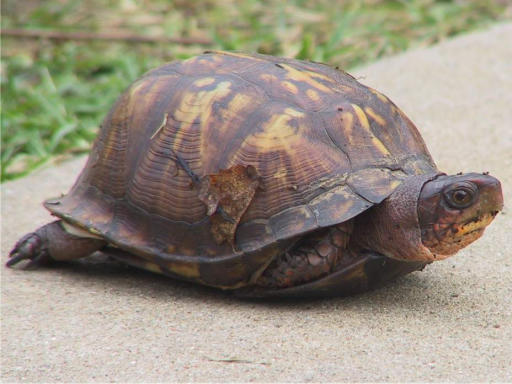
Wild Female Eastern Box Turtle –
by Wallob Hebel
People often
balk at the large tanks, expensive filters, basking platform choices & tank
cleaning regimens of aquatics. They may think a box turtle will just walk around
the Rubbermaid tub on a layer of Bed-A-Beast, poop on it once in awhile, sit
under a basking light & eat lettuce & commercial pellets.
The truth is
terrarium climates are harder to control. A well-landscaped backyard with one of
the hardier box turtles native to your area may be fairly easy to maintain, but
building a large predator-&-escape proof enclosure may be daunting. Factors like
how cool & stable you keep your house temp. & your ambient humidity over the
year have more impact on indoor land enclosures.
My view is
that aquatics are ‘easier’ (gross over-generalization), but there’s debate. The
real question is, which one’s easier for you? And more importantly, which
is more worth it to you?
III.)
Main Categories of Land-based Turtles.
Turtles are
broadly divided into 2 categories; Tortoises & ‘Turtles.’ Most turtles are
either aquatic, semi-aquatic or semi-terrestrial. The semi-terrestrials are
sufficiently land-based to qualify as ‘land’ turtles & kept in terrarium-style
setups. The semi-aquatic can be in some circumstances. Be warned:
box turtles & some tortoises don’t grow as fast as many aquatics. Baby box
turtles don’t resemble adults much until they’ve grown a good deal.
Tortoises are land-based, thick-bodied, have blunt heads/faces & have
‘tree-trunk’ legs (like an elephant). Most are nearly exclusively
herbivorous & should not be offered animal-based foods including live foods (if
watching your pet catch & eat crickets is important, skip tortoises). Some do
need small amounts of animal protein. Size ranges from box-turtle sized
Egyptians to the immense Galapagos & Aldabra tortoises (note: you can
buy those…). They can’t completely close the shell so the legs tend to be
armored. Tortoises come from a wide range of habitats (i.e.: Leopard tortoises –
desert; Red-foot tortoise – tropical savanah). Their enclosures typically don’t
require soaking pools (there are exceptions, like the red-foot) & such may pose
a drowning hazard. In the U.S. we have Gopher Tortoises in the Southeast & the
Texas & Desert Tortoises in the Southwest, drab gray but beautiful animals with
such protection that you probably don’t have the option to (legally) own one.
Nearly all U.S. pet tortoises are exotics (originating from outside the U.S.)
Some are available captive-bred & some almost all wild-caught. Get captive-bred
whenever possible. With some (i.e.: Golden Greeks) your only option is likely
wild-caught.
Box
Turtles are fairly small (by land-turtle standards) semi-terrestrial
turtles native to much of the U.S. where they spend most of their time on land
but tend to have a water body nearby. Box turtles typically have a ‘smoother’
carapace & skin, leaner & more pointed head/face & feet with toes & claws. The
plastron is hinged & (unless obese) box turtles can completely close the shell
so the legs need not be so armored. They are omnivorous & eat a substantial
amount of animal matter (including live prey items such as crickets & earth
worms) & fungi (native to their area). Their wild habitat contains many
‘microclimates,’ varied places with different environmental conditions (i.e.: of
temp. & moisture/humidity) such as meadow, forest floor, under logs or in
burrows, etc… The Eastern box turtle subspecies are from more humid environments
& the Ornate box turtles from drier habitat. They like to soak in pools &
defecate while doing so. The practical significance of this is that box turtles
need a soaking pool & water hygiene must be maintained least illnesses arise
(i.e.: a large pool with biological filtration or daily full water changes).
They don’t swim well so their pool should allow easy entry & exit. They need a
substrate they can burrow into that helps maintain enclosure humidity levels.
Box turtles have a reputation for shyness & being illness-prone in improper
environments (particularly ornates), although longer-term captives &
captive-bred individuals may be personable. Captives may quit eating & attempt
to hibernate even kept warm & indoors, which can complicate management. Adults
offered for sale are usually wild-caught (thus less acclimated to captivity,
more stressed, more likely to refuse food & more likely parasitized). If you
want captive-bred (& you do), start out with a hatchling. Hatchings are very shy
(their shells aren’t nearly as hard & the plastral hinge doesn’t completely
close for awhile so they’re vulnerable). If you want an adult, at least consider
adopting one needing a home.
Wood
Turtles are medium to large semi-aquatics spending a lot of time
on both land & in water. Historically the North American Wood Turtle was the
main species in the hobby but the beautifully patterned Central American Ornate
Wood is gaining quickly & even South American Wood and Black Wood Turtles can be
had (the Black Wood gets very large & thick and is not recommended for
beginners). Semi-aquatics not only like to soak, but actually spend substantial
time living as ‘water turtles,’ swimming about & feeding in water. For that
reason their care requires knowledge of both land-based and aquatic
turtle care, ample provision of both habitat types in their enclosures & an
omnivorous diet.
IV.)
Criteria for Choosing Your Turtle.
Let’s look
at what qualities you do & don’t want in your turtle. These guide lines will
guide your reasoning & decision-making. They assume this is your first land
turtle.
a.
Size – the turtle should be small to medium-sized, with a carapace
length under 10” & the smaller the better. Before you protest (perhaps citing
those keeping Sulcatas in their backyards in the U.S. Southwest), remember that
you may someday move to a different climate. Are you willing to setup a ½
room-sized enclosure with a custom climate for your pet if you do? Jan O. stated
they’re extremely strong & destructive & pretty much nothing would contain an
adult, although cement or concrete floors & walls could (such an abrasive
material creates its own problems…).
b.
Native vs. Exotic – When practical, I recommend keeping an animal
native to your country & locale. This improves your odds of successful outdoor
keeping & helps avoid exotic wild-caughts who’ve been through arduous overseas
shipping ordeals weakening the animal with risks of disease & over-growth of
parasites. However, native wildlife are often protected by state law,
whereas exotic wildlife may not be (a big issue for box turtle keepers).
c.
Hardy – An animal with a reputation for hardiness & trouble-free
keeping (Herman’s Tortoise) has it all over one with a rep. for being
illness-prone (Ornate Box Turtle). This is partly relative to environment (i.e.:
a tortoise hardy in arid conditions may falter in humid ones).
d.
Diet – I like turtles who eat some live food. You may not. You
must consider what foods you can offer.
e.
Climate – While this is key for outdoor keeping (arid Arizona vs.
humid Florida), you must consider indoor setups as well. Is your home typically
humid or dry? How warm are you willing to keep the enclosure? Don’t assume
tortoises from ‘hot-sounding’ habitats will love your Arizona summers; such
tort.s may aestivate in the hottest part of the year!
f.
Tolerance for Indoor Enclosure Types: some people believe land
turtles don’t understand the fact of a transparent barrier & persistently try to
walk through aquarium walls, putting them at risk for stress. A turtle known to
be content in an enclosure type has an advantage over one reputed to get
stressed & ‘anxious.’ Note: some think starting off with a hatchling in a
glass tank may avoid this problem.
g.
Personality
– ‘Outgoing’ turtles that don’t stay hidden have an
advantage over those who do. Baby box turtles are notoriously secretive & in a
proper enclosure may stay hidden most of the time. Adults may burrow into
substrate or otherwise hide.
V.)
Enclosure Needs of Land-based Turtles.
A.)
Type of Enclosure.
Outdoor Enclosure – The optimal setup for native species (in the U.S.,
box turtles) or climate-compatible exotics. Temperature, humidity, precipitation
& seasonal variation are key. Arizona’s year-round hot, dry climate makes
outdoor maintenance of sulcatas practical, where they may live much like yard
dogs. Parts of Florida enjoy year-round cool to hot, humid weather, a good match
for red-foot tortoises but a poor choice for Egyptians. Some people use outdoor
‘dog house’ type heating buildings the turtles can enter or exit at will (useful
for keeping some tortoises where the winters get cool). Recall that wild habitat
features microclimates (varied small areas offering environmental choices, like
a moist burrow or underside of a log), & your enclosure should, too. Just
fencing off a section of sunny backyard lawn won’t do.
Plan on at
least 4’x4’ & much larger preferred. Box turtles & tortoises can dig (often
well) & climb (i.e.: box turtles have claws & can climb straight up window
screen), so enclosures must be escape-proof. They must also deter predators
(neighborhood children & adults, dogs, cats, raccoon, skunk, mink, coyote, fox,
crows & fire ants). Fire ants can be lethal. Adult box turtles can
protect themselves against most non-human predators, but dogs can chew through
the shell. Your enclosure will need sections (for microclimates) with direct
sunlight, shade & cover/hide-caves (I’ve used old feed sacks & carpet). For some
species (i.e.: box turtles) heavily planting the enclosure is desirable (shade,
cover, moisture, etc…).
Humidity &
soaking needs may require you to spray the enclosure occasionally with a water
hose (hello, California water rationing!) &/or provide a large soaking
pool (for box turtles). Your pool needs gradually sloping sides to prevent
drowning. For box turtles, moist substrate to burrow in is needed (i.e.: an area
with peat moss mixed with leaf litter & misted frequently).
If you want
to hibernate or breed your turtles, you may need to provide suitable sizeable
areas for those purposes.
Top Tips for Perfect Pens (Article at Tortoise Trust).
A Secure Habitat (Article at Tortoise Trust).
Indoor Enclosure – I’ve never seen proof or universal consensus on just
how small an enclosure can be, but the 4’x4’ figure (16 square feet) has been
recommended & is a good minimum figure for 1 or 2 of the smallest land turtles
(box turtles or small tortoises). Many start out in ~ 40 gallon Rubbermaid tubs
(~ $15 at Wal-mart). These are typically not transparent (a plus for box
turtles). Whatever you choose, it must provide substrate, heat, humidity (high,
medium or low; a gradient may be best for some), basking & shaded areas & (for
box turtles) a sizeable soaking pool. It must be proof against climbing out &
raids by other pets (i.e. dogs & cats). Electric Hot Rocks are a burn-risk & to
be avoided. Heat lamps should provide broad heat; avoid ‘spot’ lamps (at least
for box turtles). Your best bet for heating is to put a heat lamp over one end
of the enclosure. Some articles mention use of under-tank heating pads; Jan O.
stated “Generally, that isn't a good idea because
torts and boxies are accustomed to getting their heat from above. They'll dig to
escape heat and if they instead find more heat it will throw their systems off.”
Don’t use ‘hot rocks’ (due to burn risk). For humidity-lovers you way
want a misting system.
A.) Substrate & Humidity
Needs.
Depend
heavily on what you keep. Substrate provides for security (by digging in),
humidity & waste absorption. Most any tortoise or box turtle likes the option to
burrow, & some burrow to access more humid/moist microclimates. Without adequate
humidity box turtles can develop health problems such as eye & ear diseases.
Humidity issues are implicated by research in pyramiding in Sulcata tortoises.
You can vary composition to get more (add peat) or less (add sand) moisture
retention. For box turtles you need at least 3” depth & more is better; ideally
a tortoise should be able to burrow so only the carapace is exposed. Many people
use top soil (rather than potting soil; you don’t want
vermiculite,
perlite or fertilizers) or Bed-A-Beast as a base substrate, adding peat to
retain moisture or sand to reduce it.
The 3 main
enclosure types for which you’ll choose substrates:
a.)
Arid Enclosure – Like for an Egyptian tortoise, golden Greek or
sulcata. A moist microclimate may be useful; some tortoises from arid environs
spend some time in fairly humid burrows. WCT notes dry hay is good for
arid-requiring species.
b.)
Moderate Humidity – At the upper end (mod./high) Eastern & 3-Toed box
turtles. At the lower end, Ornate box turtles & Herman’s tortoises. Top soil
mixed with varied amounts of play sand may serve.
c.)
High Humidity – For this you may want a substrate of topsoil mixed
with plenty of peat, misting once or twice daily & cover part of the enclosure
to trap humid air. Florida & Gulf Coast Box Turtles; Yellow-foot tortoises.
Understanding Vivarium Substrates (Article at Tortoise Trust).
Microclimates in Captivity (Article at Tortoise Trust).
TROPICAL RAINFOREST TORTOISES AND TURTLES: Practical techniques for the
provision of adequate ambient humidity in captivity (Article at Tortoise
Trust).
B.)
Lighting Issues.
Care
sheets tend to recommend full-spectrum lighting. You must understand bulbs sold
at pet stores don’t produce UV-B unless they specifically say so (no, UV-A is
not good enough). UV-B is used to convert a precursor to Vitamin D3 in the body,
critical for using calcium & without which the body mobilizes calcium from bone,
demineralizing it (Metabolic Bone Disease). While vitamin D3 can be obtained
directly from some carnivorous foods (particularly vertebrate livers), you can’t
count on box turtles getting enough in the diet & tortoises would get almost
none. Therefore, it’s recommended you provide UV-B lighting (i.e.: ZooMed
ReptiSun 5.0 bulbs changed every 6 mo-1 yr since UV-B production decays). It’s
possible to keep healthy specimens without UV-B lighting if dietary D3
supplementation is adequate (using supplements like
Rep-Cal). Providing enough calcium is not enough; they have to have
Vit. D3.
C.)
Hibernation Issues.
This
issue is contentious & beyond the scope of the article. Research your species.
Some believe hibernation is unnecessary. Some believe it prolongs life (assuming
you count months spent comatose as ‘life’). Many recommend you not hibernate
hatchlings or young juveniles, & most recommend only healthy specimens be
hibernated (not sick or underweight). Not all species hibernate equally, & some
don’t hibernate at all. Hibernation is definitely risky. Box turtles hibernated
without adequate humidity may die. Rats may devour your helpless
hibernators. Rain could drown them. Your refrigerator’s thermostat could
malfunction & freeze them. Don’t hibernate your animal until you know the in’s &
out’s of hibernation cold. Some individual box turtles quit eating
& try to hibernate even if kept warm & indoors; depending on the turtle’s
determination to hibernate & your resources, this can get serious.
Speculation: you might get less resistance to not hibernating from a
captive-bred, never-hibernated turtle.
Safer Hibernation and Your Tortoise (Article at Tortoise Trust).
Outdoor (Natural) Hibernation (Article at Tortoise Trust).
Refrigerator Hibernation for Tortoises & Turtles (Article at Tortoise
Trust).
Waking Up From Hibernation: Essential Steps for Keepers (Article at Tortoise
Trust).
18 Essential Hibernation Tips (Article at Tortoise Trust).
Hibernating Juvenile Tortoises (Article at Tortoise Trust).
Over-wintering Tortoises (Article at Tortoise Trust).
Post-Hibernation Problems in Mediterranean Tortoises (Article at Tortoise
Trust).
VI.)
Dietary Needs of Land-based Turtles.
A.) Tortoises –
Predominant herbivores with a good deal of variation. The fruit-heavy diet of
the red-foot & yellow-foot tortoises could, over time, conceivably kill a
leopard or Herman’s tortoise, yet the ‘foots aren’t suited for heavy grazing on
grasses.
Feeding Tortoises: Avoiding Dietary Disasters (Article at Tortoise Trust).
Feeding & Nutrition FAQ (Article at Tortoise Trust).
All About Vitamins, Minerals & Tortoises (Article at Tortoise Trust).
Tortoises: Do They Need to Drink? (Article at Tortoise Trust).
B.) Box Turtles –
Omnivores whose diet is controversial. Juveniles start out strongly carnivorous
& progress toward varying degrees of herbivory. Ornates are more strongly
carnivorous than other species. Wild diets vary a good deal since they’re
temperate species & plant availability is varied & seasonal. Some say the
plant/animal matter ratio should be ~ 50:50. Some might say 60:40. It depends in
part on which species, how much total you feed & what you feed from each
category (Romaine lettuce vs. Banana; crickets vs. high-protein commercial
turtle food).
VII.)
Prophylactic Antibiotic Concerns.
Any turtle
can harbor parasites & bacterial & fungal diseases. A wild-caught turtle is
practically guaranteed to harbor parasites. In the wild, these might remain
under control; the turtle excretes parasite offspring into a huge environment &
moves on. It enjoys a varied diet & natural sunlight. In an enclosure, the
turtle is confined & may be reintroduced to parasite offspring it excreted. In
the case of indirect life-cycle parasites (i.e.: tape worm) this is a non-issue
unless the intermediate host is present. In the case of direct life-cycle
parasites (i.e.: hook worm) the turtle may pick up additional parasites & in
theory be overwhelmed.
Wild-caught exotics
have often been shipped long-distance under poor conditions & are
psychologically stressed by contact with humans, neglect & unnatural
environments. They may get malnourished & dehydrated. They are at risk for
overgrowth of parasites or other disease-causing organisms.
Ideally any
wild-caught turtle should receive a standard course of prophylactic antibiotic
treatment to eliminate the prime offending organisms, & quarantine any new
turtle from your collection at least until this phase of care is
completed (better yet at least a month). With wild-caught exotics such treatment
is doubly recommended; they are at greater disease risk & may harbor exotic
parasites other pets aren’t ready for.
VIII.)
Common Box Turtle Options. Disclaimer: size estimates vary at
different sources. If it’s really important to you, check a few.
a.
Eastern Box Turtle (Terrapene
carolina carolina) – Common box turtle in the pet trade & the
‘stereotype’ others are compared to. In his care sheet Zuppa noted they can hit
6.5” & opined that they are the most adaptable & hardy U.S. box turtles & thus
most suitable for captive conditions7. ATP’s care sheet recommends
60-80% humidity. They hibernate. Estimated Cost:
Adults: Adoption-$50 Hatchlings: $25-40.
ATP’s Eastern Box Care Sheet.
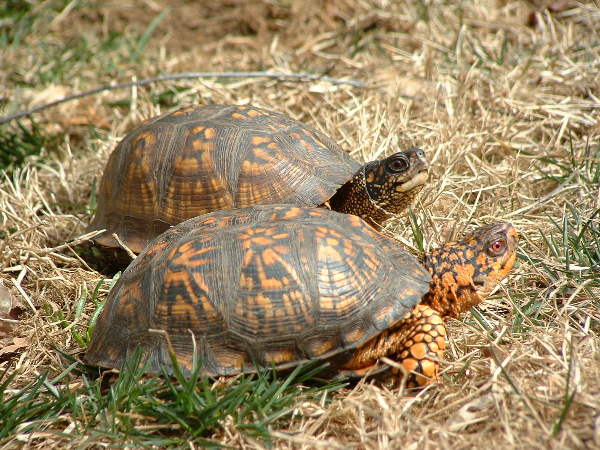
Eastern Box Turtle
Pair (Female above, male below) –
by Acutus
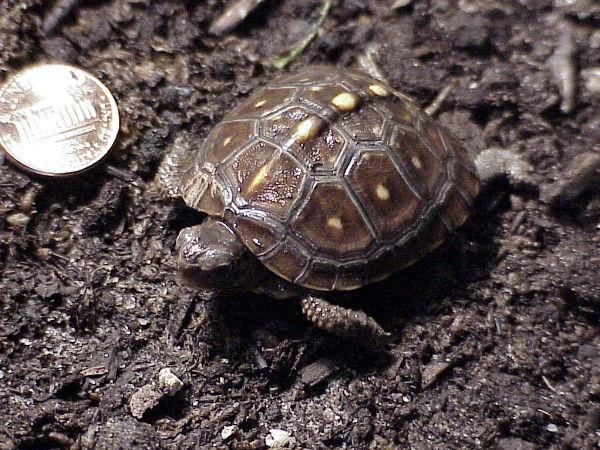
Young Juvenile
Eastern Box - by Acutus
b.
3-Toed Box Turtle (Terrapene
carolina triungis) – An Eastern
box subspecies reaching up to 6.5” & preferring drier habitat than the others7.
But don’t be fooled into thinking them arid; they need a fairly humid enclosure
with soaking pool & more humid microclimates, too. They were common where I grew
up in South-central Arkansas, quite a humid region. A.C. Highfield noted 3-toes
are particularly fond of water & really behave as a semi-aquatic turtle9!
Postings by a few keepers on the forum suggest these may be amongst the least
problem-prone of the box turtles in captivity yet their somewhat drabber
coloration seems to limit demand. They hibernate. Estimated Cost:
Adults: Adoption-$50 Hatchlings: $25-45.
Tortoise Trust’s 3-Toed Care Sheet
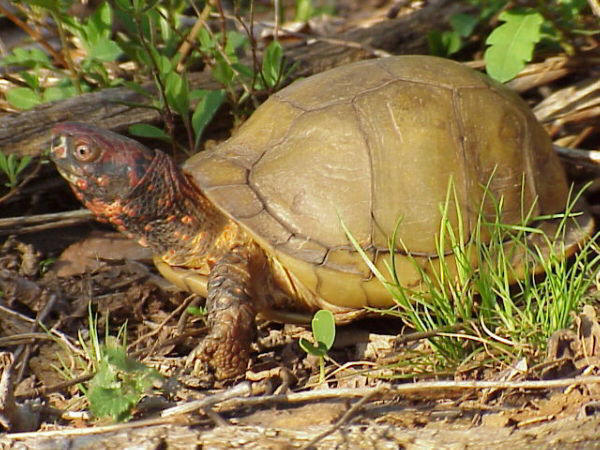
Male 3-Toed Box
Turtle – by Acutus
c.
Ornate Box Turtle (Terrapene
ornata ornata) – A number of sources (including Tortoise Trust’s
care sheet & our forum members’ first-hand experience) indicate these are
possibly the most problem-prone U.S. box turtle in captivity. Very bad choice
for a first turtle (possibly a bad choice, period). Any adult is presumed
wild-caught until proven otherwise. They’re small at up to 5.5”7.
Ornates are more dry-tolerant than the Eastern subspecies but still like to soak
& need humid microclimates (but not overall wet conditions – they have
trouble adapting to chronically humid conditions.)7 ATP’s care sheet
recommends 30-60% humidity. More carnivorous than the Eastern box species.
Estimated Cost: Adults: Adoption-$30 Hatchlings:
$20-40.
ATP’s Ornate Box Care Sheet.
Tortoise Trust’s Ornate Care Sheet.
d.
Florida Box Turtle (Terrapene carolina bauri)– An
Eastern box subspecies. Most expensive of the U.S. box turtles. ATP’s care sheet
states they hit up to 6.5” & recommends 70-90% humidity. They have a carnivorous
bent. Estimated Cost: Adults: Adoption-$250
Hatchlings: $100-130.
ATP’s Florida Box Care Sheet.
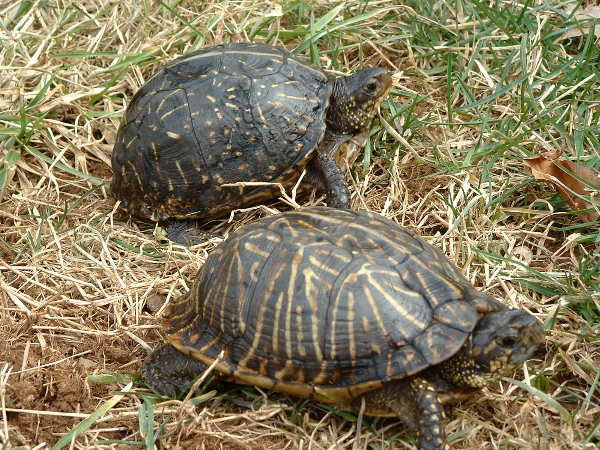
Pair of Florida Box
Turtles (Female above, male below) –
by Acutus
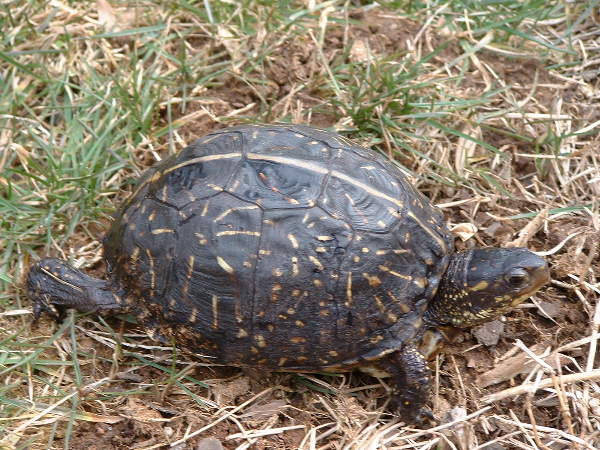
Female Florida Box
Turtle – by Acutus
e.
Gulf Coast Box Turtle (Terrapene carolina major) –
Largest of the U.S. box turtles (can clear 8”), an Eastern box subspecies & very
moisture-loving; may enter dormancy but not a true hibernator7.
Conner notes they hail from the very humid south, captives spend considerable
time in water, males are very aggressive toward each other (keep separately), &
one of his 2 males over-wintered under water in a pond for at least 4 winters
running but the other over-wintered in the ground10. Estimated
Cost: Adults: Adoption-$50 Hatchlings: $40-60.
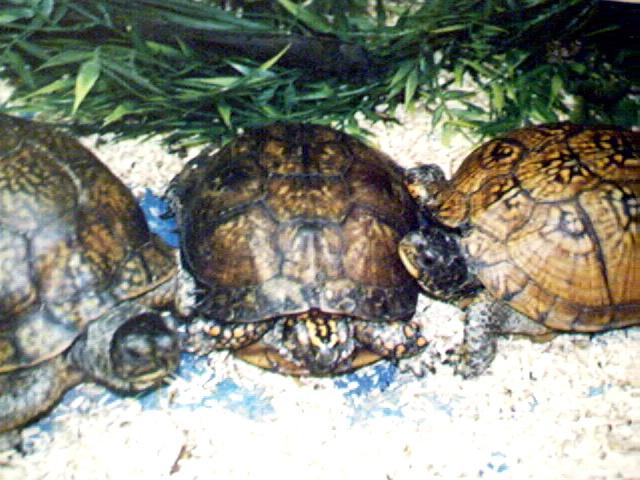
Gulf Coast Box Turtle Trio
.jpg)
Female Gulf Coast Box Turtle
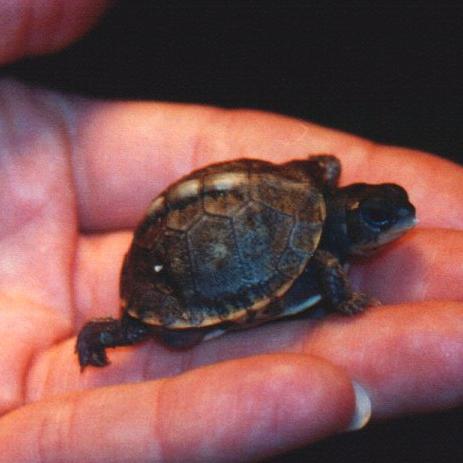
Hatchling Gulf Coast Box Turtle
f.
Desert Box Turtle (Terrapene ornate luteola) – a
subspecies of the ornate. Inhabits the driest habitat of the U.S. box turtles;
they need a humid microclimate but not overall wet conditions7. I
don’t see much specific to this subspecies online, hear much from keepers on the
forum & their fellow subspecies (the ornate) is a dismal choice for first land
turtle, so I don’t recommend these, either. However, forum regular Robert Zebeck
noted “Luteolas
are not very widespread in the trade but here in Az they are a pretty common
"pet" turtle. Much like the way easterns and three-toeds are in the east, many
people here find a luteola wandering on their property and decide to keep
it. Even the novices here seem to have very little trouble with them.” He also
stated “Deserts also seem to be able to handle the lower humidity conditions
that newbies often subject their box turtles to. I guess the reasons are
obvious. But again, they are not tortoises. They are found here in proximity to
streams and forests (yes there are some trees in Arizona) and though they
venture out when it’s 100 degrees and wander the grasslands and even the high
desert, they do desiccate much faster than the local Gopherus.”
Estimated Cost: Zebeck said adults usually go for about $100 each; cb
hatchlings $75-100.
General Box Turtle Care
– Indoors at least a 40 gallon shallow tub for 1, & larger is better.
Include at least 3” depth substrate; substrate choice will vary with type (Gulf
Coast vs. Ornate) but a mix of top soil & peat is good for some of the better
starting pets. You can put more peat in an area with a hide box or log to
provide a more humid microclimate the turtle can use. Include ‘hide box’
features at both warm & cool ends. Try for a temperature gradient ranging from
low-mid. 70’s at one end to upper 80’s at the other. The warm end should have a
basking light (flood, not spot), no hot rock, & some question use of
heating pads (see Indoor Enclosures section). UV-B lighting recommended.
A soaking tub with easy entry/egress should always be present; change the water
daily or provide a larger volume & biofiltration. Species choice & your house’s
temp./humidity will suggest whether to use a mister system. Outdoors figure on
at least a 4’x4’ pen, much larger much better, & provide for a varied habitat to
provide microclimates (i.e.: a large compost pile & large rotting log). Escape
from the heat/sun, predator-proofing & escape-proofing are critical. Males may
fight or harass females to mate so beware how you ‘grow’ your collection. Jan O.
noted “It's also a good idea (indoors or outdoors) to
use objects to break up the line-of-sight. This makes the enclosure feel larger
to the turtle and there will be less tendency for it to try to patrol the
boundaries and try to escape.”
WCT’s North American Box Turtles Care Sheet.
Box Turtles (Article by Melissa Kaplan).
Avoiding Problems with Box Turtles (Article at Tortoise Trust).
Care of Box Turtles (Article at California Turtle & Tortoise Club).
Box Turtles (Genus Terrapene) (Article by Petra Lowe – CHS Member).
Box Turtle Care A-Z (A Complete Guide for Box Turtle Owners) (Article at Box
Turtle Care & Conservation Web Page).
Box Turtles – Difficult, but Fascinating Captives (Article by Petra Spiess-Rocky
Mountain Herpetoculture – appeared in 8/97 issue of Reptile Hobbyist).
United States’ Box Turtles (Article by Michael J. Conner. Tortuga Gazette
30(4): 1-3, April 1994.
Bottom Line: Most
people recommend an Eastern or 3-Toed for a first box turtle. Avoid ornates.
IX.)
Common Tortoise Choices. Disclaimer: size estimates vary at
different sources. If it’s really important to you, check a few.
a.
Herman’s Tortoise (Testudo hermanni) – One of the
most popular pet tortoises; one of the Mediterranean tortoises. 2 Subspecies
(Eastern & Western). A small-medium tortoise, Western (~ 5” SCL) smaller than
Eastern (some can easily hit ~ 10” SCL). Highfield1 states their
natural habitat is evergreen Mediterranean oak forest, but due to habitat
reduction they’re found in secondary maquis type environments typically
comprising coarse, arid & scrubby hillsides. He notes they’re resilient &
adaptable in captivity, seem equally at home in arid or even moderately damp
environments (but plenty of sun & warmth are essential), & the natural diet
consists of herbaceous & succulent plants. Highfield’s1 discussion
indicates they should get a strictly vegetarian high-fiber diet without
excessive fruit (though they enjoy it) but a wide range of weeds & green
vegetation. ATP’s care sheets recommend 30-50% humidity. They can hibernate.
Estimated Cost: Adults: $50-60 Hatchlings:
$90-110.
ATP Eastern Herman’s (Testudo hermanni boettgeri) Care Sheet.
ATP Western Herman’s (Testudo hermanni hermanni) Care Sheet.
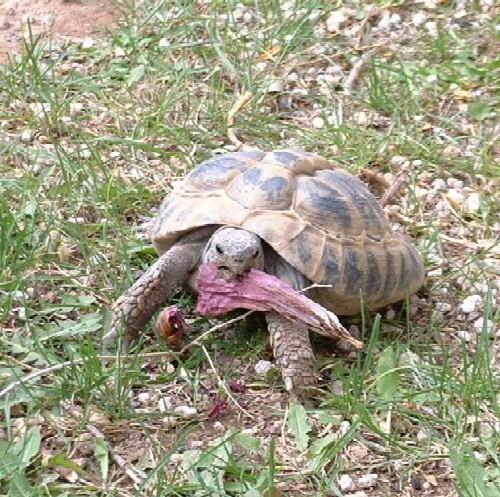
Eastern Herman's
Tortoise – by Jan O.
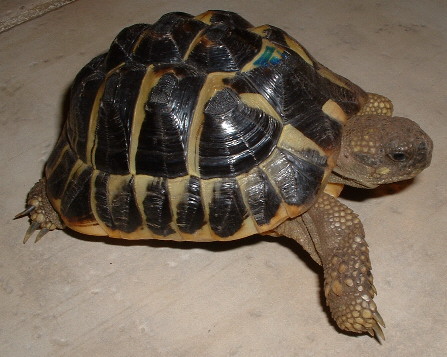
Western Herman's
Tortoise – by Evan D.
b.
Russian Tortoise (Testudo horsfieldi) – Another very
popular pet tortoise native to the former USSR & Pakistan area. Range from 4-10”
(females > males). ATP’s care sheet notes they hail from
harsh and arid landscapes ranging from sandy steppes to rocky and hilly
topography, sometimes at elevations above 5000 feet. Use an arid-type substrate.
They are burrowers & burrows can be humid, but for Russians the combination of
‘cool’ & ‘humid’ can cause sickness. Provide a high-fiber & calcium
low-protein 100% vegetarian diet (so a grazer; keep fruit to a minimum - or
none). Males can be aggressive toward other Russians. ATP’s care sheet
recommends humidity be kept under 40%. (RussianTortoise.org’s
care sheet describes a Rubbermaid tub setup that keeps humidity ~ 60%). They
can aestivate & hibernate. Estimated Cost:
Adults: $30-50 Hatchlings: $150-175.
ATP Russian Care Sheet.
WCT Care Sheet.
The Russian Tortoise (a comprehensive online info. site).
Practical Care & Breeding of the Horsefield’s or Russian Tortoise in Captivity
(Article at Tortoise Trust).
A Habitat for Horsfields – (Article at Tortoise Trust – A.C. Highfield).
Practical Experiences of Keeping the Russian Tortoise (Article at Tortoise
Trust).
The Horsfield’s Tortoise: Testudo horsfieldi (GRAY) 1844 – A brief review
of its biology, ecology & captive breeding (Article at Tortoise Trust).
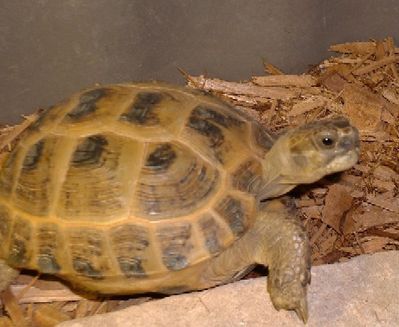
Russian Tortoise –
by Jan O.
c.
Greek Tortoise (Testudo ibera) – One of the
Mediterranean tortoises with quite a bit of morphological variation over the
range (they don’t all look alike). Females are significantly larger than males (SCL
~ 7-8”). Highfield’s Practical Encyclopedia1 notes they are a
“…relatively tenacious and robust species capable of withstanding considerable
extremes of climate,” & indicates the diet is as per a Herman’s tortoise. They
can be hibernated. Estimated Cost:
Adults:
$50-75 Hatchlings: $90-100.
Mediterranean Spur Thigh ‘Greek Tortoise’ (Article at WCT).
Basic Care of Mediterranean Tortoises (Article at Tortoise Trust).
Feeding Mediterranean Tortoises – Basic Guidelines (Article at Tortoise
Trust).
Mediterranean Tortoises – How Much to Feed (Article at Tortoise Trust).
d.
Golden Greek Tortoise – Highfield notes they aren’t a
single subspecies or even species but rather a shared set of physical
characteristics8. He notes they occur in hot, dry arid regions & in
captivity need low-humidity enclosures with relatively dry substrate. It’s my
understanding from our forums those in the pet trade are wild-caught.
Wild-caught tortoises from particularly specialized environments, they aren’t
good beginner tort.s.
The Mystery of the Golden Greeks (Article at Tortoise Trust). In
WCT’s care sheet on golden greeks Senneke notes they tend to bury themselves
in topsoil or under the base of grass clumps & if the substrate’s damp this may
result in a high-humidity microclimate, & (even if kept warm) in a humid
environment many develop upper respiratory tract disease. He doesn’t recommend
trying to hibernate them. Estimated Cost:
Adults: $40-75 Hatchlings: None Available Yet.
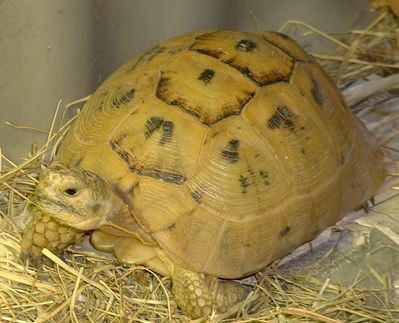
Golden Greek Tortoise –
by Jan O.
e.
Egyptian Tortoises (Testudo kleinmanni) – One of the
Mediterranean tortoises & the smallest tortoise you can buy at ~ 4-5” SCL
(females > males). They hail from fairly arid deserts fringing the south eastern
coasts of the Mediterranean Sea, extending as far as 120 km inland at some
points6. They require warm arid enclosures & don’t tolerate high
humidity. Constant water access isn’t necessary but offer water daily & an
occasional soak may be appreciated. Per Highfield’s book1, Tortoise
Trust maintains them on a 100% vegetarian high fiber & calcium low protein diet
with no fruit except occasional tomato (calcium & Vit. D3 supplements are used),
water available at all times ‘if required,’ the substrate used is 60% dry
loam/40% sand & day temp.s are kept around 17-24° C (with the admonition people
often keep Egyptians too warm). While desert animals must often tolerate rather
chill nights, Egyptians don’t hibernate.
WCT’s care sheet states they’re difficult to maintain, extremely sensitive
to diseases carried by other species (don’t mix with other
species) & not appropriate for the beginning tortoise keeper. Included
here because their size, attractiveness & availability may tempt you.
Estimated Cost:
Due to protection, most are CB
and cost $250-500.
WCT’s Egyptian Tortoise Care Sheet.
The Egyptian Tortoise Website.
Status of the Egyptian Tortoise in Egypt (Article at Tortoise Trust).
%20-%20Jan%20O..jpg)
Wild-caught
Egyptian Tortoises (Female Left, Male Right) –
by Jan O.
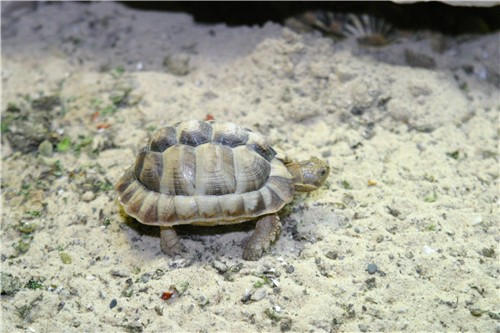
Egyptian Tortoise –
by Richard Lunsford
f.
Red-foot Tortoise (Geochelone
carbonaria) – Fairly large (typically ~ 14” SCL; can hit 20”)
South American grassland savannah & drier forest tortoise with more fruit in the
diet than some tort.s that also ingests a small amount of animal matter in
nature1. They require constant access to water pool (like box
turtles). They don’t hibernate & keeping outdoors in cooler parts of the U.S.
may prove challenging (see the ‘Husbandry in Europe’ article linked below for
tips). In some areas they must come in for the winter. There’s a smaller variant
called the cherry-head, reaching ~ 10-12.”7 A similar, larger species
is the yellow-foot tortoise (Geochelone denticulate), typically around
18” SCL, from tropical & sub-tropical forests – needs constant access to
drinking water & a soaking pool1. Estimated Cost:
Adults: $100 Hatchlings: $75-125.
ATP Red-foot Care Sheet.
WCT’s Red-foot Tortoise Care Sheet.
Redfoot Tortoise Outdoor Husbandry in Europe (Article at Tortoise Trust).
Feeding Redfoot & Yellowfoot Tortoises (Article at Tortoise Trust).
WCT’s Yellow-foot Tortoise Care Sheet.
.jpg)
Red-foot Tortoise –
by Chris H
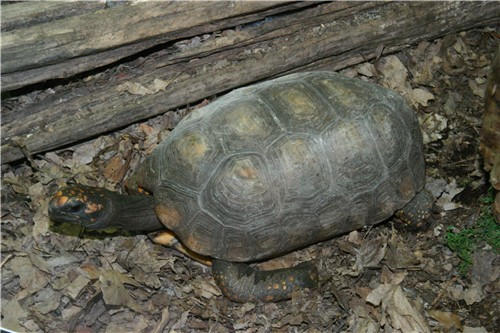
Yellow-foot
Tortoise – by Richard
Lunsford
g.
Sulcata Tortoise (Geochelone sulcata) –
a.k.a. African spurred tortoise. 3’rd largest tortoise on Earth (may reach ~2 ¾’
SCL). Hail from Africa & other places, inhabiting arid savannahs & acacia scrub
land (so sub-Saharan African semi-desert habitat).1 Grazers requiring
high fiber/roughage diet; don’t overdo fruits & avoid animal protein.1
Like any grazing herbivore, they produce plenty of stool. Improper diet can
cause pyramiding; research has shown so can certain humidity problems. Can
burrow & aestivate but not hibernate. Captive-bred readily available. A bad
choice for anyone except those with year-round outdoor keeping options &
long-term stability. Jan O. stated Sulcatas are strong & destructive, & being
large grazers one will need as much as an acre of land! Remember it may outlive
you & be hard to re-home. Estimated Cost:
Adults: Adoption-$200 (most people ask for more, but $200 should be the absolute
maximum paid due to popularity in shelters). Hatchlings: $30-60.
WCT’s Sulcata Care Sheet.
Tortoise Trust’s Sulcatta Care Sheet.
General Tortoise Care – Tortoises
are too diverse for useful general guidelines. There’s just no way to give a
minimum enclosure size, temp., humidity & substrate covering a Cherry-head
Red-foot & a Sulcata! It’s strongly recommended you not mix species & males may
fight & be incompatible so be careful how you ‘grow’ your collection.
Basic Tortoise Care (Article at WCT).
7 Simple Steps to Successful Tortoise Keeping (Article at Tortoise Trust).
The Maintenance and Breeding of Tortoises and Turtles in Cold Climates; a review
of Housing methods employed by The Tortoise Trust (Article at Tortoise
Trust).
Bottom Line: Herman’s & Russians are commonly
recommended for first tortoises, with Greeks a decent option. Stay away from
Golden Greeks & especially Egyptians. Red-foot, yellow-foot & sulcata are large
enough to mandate outdoor setups, yet aren’t temperate species so you need a
plan for outdoor winter management.
X.)
Tortoises vs. Box Turtles as Your First Land Turtle.
By now you
see not all tortoises or box turtles are created equal, & both groups have very
real advantages & disadvantages relative to each other. To level the playing
field we’ll look at the ‘best’ starter options of both groups. The best starter
tortoises are the Herman’s, Russian & Greek. The best starter box turtles are
the Eastern & 3-toed.
These box
turtles require a soaking pool, daily water changes, humid enclosure & animal
protein often including live prey. You may need to pay more attention to setting
up diverse microclimates (an area with extra peat that stays damper, etc…).
These
tortoise species don’t require a soaking pool (offer fresh drinking water at
least once daily), require less humidity (could be a bad thing if your home is
cool & damp) & should have high-fiber & calcium low-protein 100% vegetarian
diets (mostly grazing greens; don’t give much fruit). The Western
subspecies of the Herman’s Tortoise is smaller than the others, & Herman’s are
adapted for a more humid environment than the Russian.
My
recommendation from all this: For indoor enclosures, choose between an
Eastern or 3-Toed Box turtle & a Western Herman’s Tortoise.
XI.)
Checklist for Choosing Your First Land Turtle.
a.
Are you ready to commit lots of money, time & effort over a few decades?
If not, don’t get a turtle. Any turtle.
b.
Have your ruled out aquatic turtles? If not, hit
Austin’s Turtle Page & our
Article on Choosing Your First Turtle.
c.
Which box turtles (& tortoises) are illegal in your state? Decide whether
you’re willing to break the law & can keep it hidden. (Disclaimer: our
sites don’t endorse illegal activity).
d.
Do you demand a species that can live outdoors all year in a temperate
climate? If so, avoid tropical species like red-foot & yellow-foot tortoises.
e.
Do you demand a species that can handle indoor living?
f.
Do you demand a ‘small’ (under 10” carapace) species? If so, avoid larger
tortoises like Sulcatas, redfoot & yellow-foots & go with Herman’s, Russian’s,
Greek’s or box turtles.
g.
Are you in a humid climate?
h.
Are you in an arid climate?
i.
Do you want to feed live food items? Avoid most tortoises & go with a box
turtle (likely 3-toed or Eastern; avoid ornates for other reasons).
j.
Do you want to hibernate the animals? Avoid tropicals like sulcata,
red-foot & yellow-foot tortoises.
Appendices:
I.) Interesting Articles Online:
Enclosure-Related:
Top Tips for Perfect Pens (Article at Tortoise Trust).
A Secure Habitat (Article at Tortoise Trust).
Quick & Simple Emergency Housing for Tortoises & Turtles – A.C. Highfield
(Tortoise Trust).
Understanding Vivarium Substrates (Article at Tortoise Trust).
Microclimates in Captivity (Article at Tortoise Trust).
TROPICAL RAINFOREST TORTOISES AND TURTLES: Practical techniques for the
provision of adequate ambient humidity in captivity (Article at Tortoise
Trust).
Hibernation-Related:
Safer Hibernation and Your Tortoise (Article at Tortoise Trust).
Outdoor (Natural) Hibernation (Article at Tortoise Trust).
Refrigerator Hibernation for Tortoises & Turtles (Article at Tortoise
Trust).
Waking Up From Hibernation: Essential Steps for Keepers (Article at Tortoise
Trust).
18 Essential Hibernation Tips (Article at Tortoise Trust).
Hibernating Juvenile Tortoises (Article at Tortoise Trust).
Over-wintering Tortoises (Article at Tortoise Trust).
Post-Hibernation Problems in Mediterranean Tortoises (Article at Tortoise
Trust).
Diet-Related:
Feeding Tortoises: Avoiding Dietary Disasters (Article at Tortoise Trust).
Feeding & Nutrition FAQ (Article at Tortoise Trust).
All About Vitamins, Minerals & Tortoises (Article at Tortoise Trust).
Tortoises: Do They Need to Drink? (Article at Tortoise Trust).
Feeding Mediterranean Tortoises – Basic Guidelines (Article at Tortoise
Trust).
Mediterranean Tortoises – How Much to Feed (Article at Tortoise Trust).
Feeding Redfoot & Yellowfoot Tortoises (Article at Tortoise Trust).
Care Sheets /Husbandry:
Box
Turtles:
WCT’s North American Box Turtles Care Sheet.
Box Turtles (Article by Melissa Kaplan).
Avoiding Problems with Box Turtles (Article at Tortoise Trust).
Care of Box Turtles (Article at California Turtle & Tortoise Club).
Box Turtles (Genus Terrapene) (Article by Petra Lowe – CHS Member).
Box Turtle Care A-Z (A Complete Guide for Box Turtle Owners) (Article at Box
Turtle Care & Conservation Web Page).
Box Turtles – Difficult, but Fascinating Captives (Article by Petra Spiess-Rocky
Mountain Herpetoculture – appeared in 8/97 issue of Reptile Hobbyist).
United States’ Box Turtles (Article by Michael J. Conner. Tortuga Gazette
30(4): 1-3, April 1994.
ATP’s Eastern Box Care Sheet.
Tortoise Trust’s 3-Toed Care Sheet.
ATP’s Ornate Box Care Sheet.
Tortoise Trust’s Ornate Care Sheet.
ATP’s Florida Box Care Sheet.
Tortoises:
Basic Tortoise Care (Article at WCT by Paula Morris).
7 Simple Steps to Successful Tortoise Keeping
(Article at Tortoise Trust).
The Maintenance and Breeding of Tortoises and Turtles in Cold Climates; a review
of Housing methods employed by The Tortoise Trust (Article at Tortoise
Trust).
ATP Eastern Herman’s (Testudo hermanni boettgeri) Care Sheet.
ATP Western Herman’s (Testudo hermanni hermanni) Care Sheet.
ATP Russian Care Sheet.
WCT Russian Tortoise Care Sheet.
The Russian Tortoise (a comprehensive online info. site).
Practical Care & Breeding of the Horsefield’s or Russian Tortoise in Captivity
(Article at Tortoise Trust).
A Habitat for Horsfields – (Article at Tortoise Trust – A.C. Highfield).
Practical Experiences of Keeping the Russian Tortoise (Article at Tortoise
Trust).
The Horsfield’s Tortoise: Testudo horsfieldi (GRAY) 1844 – A brief review
of its biology, ecology & captive breeding (Article at Tortoise Trust).
Mediterranean Spur Thigh ‘Greek Tortoise’ (Article at WCT by Darrell Senneke).
Basic Care of Mediterranean Tortoises (Article at Tortoise Trust).
Feeding Mediterranean Tortoises – Basic Guidelines (Article at Tortoise
Trust).
Mediterranean Tortoises – How Much to Feed (Article at Tortoise Trust).
WCT’s Care Sheet on Golden Greeks (Care sheet by Darrell Senneke).
The Mystery of the Golden Greeks (Article at Tortoise Trust).
WCT’s Egyptian Tortoise Care Sheet (Article by Chris Tabaka DVM & Darrell
Senneke).
The Egyptian Tortoise Website.
Status of the Egyptian Tortoise in Egypt (Article at Tortoise Trust).
ATP Redfoot Care Sheet.
WCT’s Red-foot Tortoise Care Sheet.
Redfoot Tortoise Outdoor Husbandry in Europe (Article at Tortoise Trust).
WCT’s Yellow-foot Tortoise Care Sheet.
WCT’s Sulcata Care Sheet (Article at WCT by Darrell Senneke & Chris
Tabaka DVM).
Tortoise Trust’s Sulcatta Care Sheet.
II.) Useful Websites:
Austin’s Turtle Page – Our parent site & top-notch guide to general turtle
information, husbandry, equipment & species-specific care information. Dedicated
to the excellence in husbandry & enjoyment of the both the hobby & field herping.
World Chelonian Trust – Our fellow
ITTN affiliate with a huge array of turtle & tortoise-related information,
including large photo galleries helpful for identification.
Tortoise Trust – An awesome compilation of husbandry & natural history info.
on a large variety of chelonians, with particularly good tortoise offerings but
also considerable aquatic coverage. While I’ve provided links to many relevant
Tortoise Trust articles, they have many more & additional offerings besides.
Turtle Forum – Our online community for discussion off all things ‘turtley’
& much more. Sponsored by ATP.
III.) Useful Books:
1.)
Practical Encyclopedia of Keeping and Breeding Tortoises and Freshwater Turtles
(Softcover) by A. C. Highfield. 295 pages. Carapace Press. May 1996.
Now sold here.
2.)
Keeping and Breeding Freshwater Turtles (soft cover) by Russ Gurley. 301
Pages.
Living Art Publishing. 2003. Covers box turtles & aquatics but not
tortoises.
3.)
Turtles of the World CD &
soft cover versions by Carl H. Ernst & Roger W. Barbour. 290 pages.
Smithsonian Institution Press. November 1992. Not used for this article but a
fine natural history guide covering turtles & tortoises of the world.
4.)
The Tortoise and Turtle Feeding Manual – by A. C. Highfield. 52
pages. Carapace Press. July 4, 2000.
Buy it here.
5.)
The Box Turtle Manual - by Phillippe de Vosjoli & Roger Kligenberg. 16
Pages. Advanced Vivarium Systems. June 1996.Per our forum goers the ‘must own’
guide to captive care & maintenance of North American Box Turtles.
6.)
North American Box Turtles: A Natural History - by Kenneth C. Dodd Jr. 231
pages. Univ. of Oklahome Pr (Trd). August 2002. Per our forum goers, a great
book on the natural history of box turtles.
IV.) Videos Available.
Carapace Press has several video products available on varied tortoise
subjects, & at least one on the care of box turtles. I have not personally
reviewed any of their tortoise or box turtle videos yet, but you may wish to
consider them.
V.) Relative Cost of a Box Turtle or Tortoise.
(Special thanks to Jeff H. for researching & writing this section).
Eastern Box Turtle (Terrapene
carolina carolina):
Adults: Adoption-$50
Hatchlings: $25-40
3 Toed Box Turtle (Terrapene carolina triungis):
Adults: Adoption-$50
Hatchlings: $25-45
Ornate Box Turtle (Terrapene ornata ornata):
Adults: Adoption-$30
Hatchlings: $20-40
Florida Box Turtle (Terrapene carolina bauri):
Adults: Adoption-$250
Hatchlings: $100-130
Gulf Coast Box Turtle (Terrapene carolina major):
Adults: Adoption-$50
Hatchlings: $40-60
Desert Box Turtles (Terrapene ornata luteola):
I have no idea to tell you truth, I never see these for sale. So my guess would
be $$$.
(Editorial Insertion:
Zebeck said adults usually go for about $100 each; cb hatchlings
$75-100).
Hermann's Tortoise (Testudo hermanni):
Adults: $50-60
Hatchlings: $90-110
Russian Tortoise (Testudo(Agrionemys) horsfieldii):
Adults: $30-50
Hatchlings: $150-175
Greek Tortoise (Testudo ibera):
Adults: $50-75
Hatchlings: $90-100
Golden Greek Tortoise (Testudo ibera):
Adults: $40-75
Hatchlings: None Available Yet
Egyptian Tortoises (Testudo kleinmanni):
Due to protection, most are CB and cost $250-500
Redfoot Tortoises (Geochelone carbonaria):
Adults: $100
Hatchlings: $75-125
Sulcata Tortoises (Geochelone sulcata):
Adults: Adoption-$200 (most people ask for more, but $200 should be the absolute
maximum paid due to popularity in shelters).
Hatchlings: $30-60
For adults, you can assume most are WC. The only exception would be the sulcata
tortoises.
References.
1.)
Practical Encyclopedia of Keeping and Breeding Tortoises and Freshwater Turtles
(Softcover) by A. C. Highfield. 295 pages. Carapace Press. May 1996.
Now sold here.
2.)
Keeping and Breeding Freshwater Turtles (soft cover) by Russ Gurley. 301
Pages.
Living Art Publishing. 2003. Covers box turtles & aquatics but not
tortoises.
3.)
Turtles of the World CD &
soft cover versions by Carl H. Ernst & Roger W. Barbour. 290 pages.
Smithsonian Institution Press. November 1992. Not used for this article but a
fine natural history guide covering turtles & tortoises of the world.
4.)
The Tortoise and Turtle Feeding Manual – by A. C. Highfield.
52 pages. Carapace Press. July 4, 2000.
Buy it here.
5.)
The Box Turtle Manual - by Phillippe de Vosjoli & Roger Kligenberg. 16
Pages. Advanced Vivarium Systems. June 1996.Per our forum goers the ‘must own’
guide to captive care & maintenance of North American Box Turtles. I don’t have
one yet.
6.)
Status of the Egyptian Tortoise in Egypt - Sherif and Mindy Baha El Din,
TortoiseCare; Submitted to the Turtle Recovery Programme, Wildlife Conservation
Society, August 1994 –Article online at TortoiseTrust.org.
7.)
North American Box Turtles (Terrapene) – Steve Zuppa. Copyright 2003 World
Chelonian Trust.
8.)
The Mystery of the Golden Greeks (Article at Tortoise Trust by A.C.
Highfield).
9.)
Avoiding Problems with Box Turtles (Article at Tortoise Trust by A.C.
Highfield).
10.)
United States’ Box Turtles (Article by Michael J. Conner. Tortuga Gazette
30(4): 1-3, April 1994.
|